JILPT Research Report No.174
Comparative Analysis of Employment Dispute Cases Resolved by Labour Bureau Conciliation, Labour Tribunals and Court Settlement
April 20, 2015
Summary
Research Objective
In the revised “Japan Revitalization Strategy” of 2014 (decided by the Cabinet on June 24, 2014), it was expressly stated that cases of conciliation by Prefectural Labour Bureaus, mediation and adjudication by labour tribunals, and settlement of civil litigation used as means of resolving labour disputes would be analyzed and classified during FY2014. Based on this requirement, the analysis and classification work has been carried out by the Japan Institute for Labour Policy and Training with the cooperation of the courts, in response to a request from the Ministry of Health, Labour and Welfare.
Research Method
Cases surveyed were as follows.
- Conciliation by Prefectural Labour Bureaus (hereinafter “conciliation”): 853 cases of individual labour-related disputes received by four Labour Bureaus in FY2012.
- Mediation and adjudication by labour tribunals (hereinafter “labour tribunals”): 452 cases of labour tribunals in which mediation or adjudication was concluded by four district courts in 2013.
- Settlement of civil litigation (hereinafter “settlement”): 193 cases of settlement of labour-related civil litigation concluded by four district courts in 2013.
∗As the conciliation system is voluntary, cases sometimes go unresolved when the other party to the conciliation request declares non-participation or the conciliation has failed. Nevertheless, the rate of resolution by conciliation is in an upward trend, the ratio of cases ending in agreement rising from 30.2% in FY2008 to 38.0% in FY2012.
(Note) The survey covered all cases of individual labour-related disputes conciliated by Prefectural Labour Bureaus, and all cases of mediation or adjudication by labour tribunals and court settlement except those involving a monetary claim. As such, besides cases of dismissal and other employment termination, cases of reduced labour conditions, offers of early retirement, job reassignment and others are also included in the scope of the survey.
Major Findings
- Gender
The male-female breakdown was 53.6%and 46.4% for conciliation, 68.6%and 31.4% for labour tribunals and 77.2%and 22.8% for court settlement respectively, revealing a higher male ratio for the latter.
- Employment status
The breakdown between standard employees and directly-hired non-standard employees was 47.1% and 38.1% for conciliation, 75.7% and 21.0% for labour tribunals and 79.8% and 19.2% for court settlement respectively, revealing a higher ratio of standard employees for the latter.
- Years of service
The median value was 1.7 years for conciliation, 2.5 years for labour tribunals and 4.3 years for court settlement, revealing a greater use of the latter by longer-serving employees.
- Managerial and supervisory personnel
The ratio of managerial and supervisory personnel was 4.9% for conciliation, 12.4% for labour tribunals and 22.8% for court settlement, revealing a greater use of the latter by managerial and supervisory personnel.
- Monthly wage
The median value was 191,000 yen for conciliation, 264,222 yen for labour tribunals and 300,894 yen for court settlement, revealing a greater use of the latter by higher-paid workers.
- Corporate scale (number of employees)
Analysis of labour tribunals and court settlement is not detailed enough, as data are unobtainable in many cases (a bias arises from the fact that the number of employees is easier to ascertain as the corporate scale decreases). Nevertheless, the median value was 40 for conciliation, 30 for labour tribunals and 50 for court settlement.
- Time span of system use
The median value was 1.4 months for conciliation (resolved cases only), 2.1 months for labour tribunals and 9.3 months for litigation (settlement), revealing a longer period for litigation.
- Time span needed for resolution
The median value of the time from the start of a case to resolution was 2.1 months for conciliation, 5.1 months for labour tribunals and 14.1 months for court settlement, revealing a longer period for the latter.
- Use of attorneys, etc.
Contrasting results were obtained on the use of attorneys, in that attorneys were used by neither labour nor management in 95.0% of conciliation cases (use by workers was 0.7%), but by both labour and management in 88.9% of labour tribunals and 95.3% of court settlement. In conciliation cases, moreover, use of certified social insurance labour consultants are allowed, but these again were used by neither labour nor management in 94.0% of cases.
- Amount claimed
The median value was 600,000 yen for conciliation, 2,600,000 yen for labour tribunals and 5,286,333 yen for court settlement, revealing higher amounts for the latter.
- Resolution content
(Hereinafter, limited to cases of conciliation in which agreement was reached.) The ratio of monetary settlement was 96.6% for conciliation, 96.0% for labour tribunals and 90.2% for court settlement, revealing an overwhelmingly high ratio of monetary settlement in each case.
- Resolution amount
The median value was 156,400 yen for conciliation, 1,100,000 yen for labour tribunals and 2,301,357 for court settlement, revealing higher amounts for the latter. However, there was a wide scattering, as shown in the tables below.
Figure 1. Resolution amounts (conciliation, FY2012)
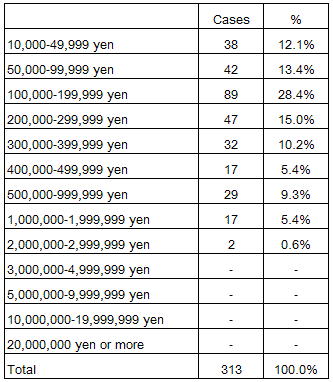
Figure 2. Resolution amounts (labour tribunals)
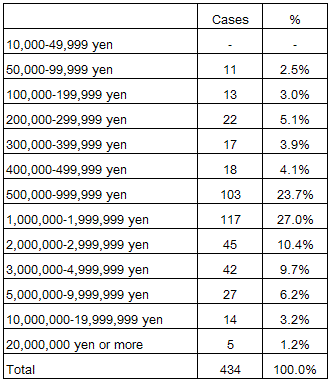
Figure 3. Resolution amounts (court settlement)
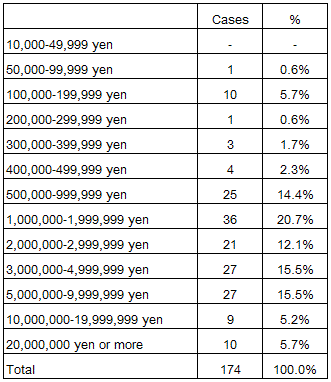
- Resolution amounts in terms of monthly income
When resolution amounts were divided by monthly wage amounts, median values were 1.1 months for conciliation, 4.4 months for labour tribunals and 6.8 months for court settlement, revealing higher amounts for the latter. However, there was a wide scattering in each case, as shown in the tables below.
Figure 4. Resolution amounts in terms of monthly income (conciliation FY2012)
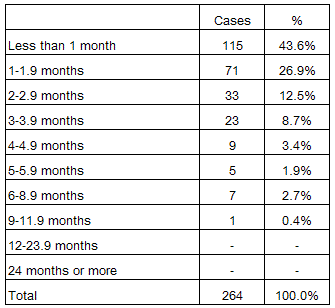
Figure 5. Resolution amounts in terms of monthly income (labour tribunals)
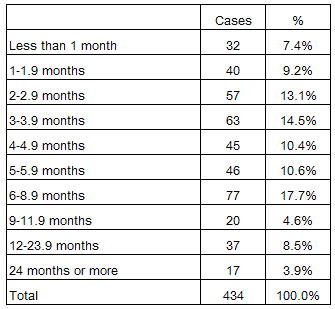
Figure 6. Resolution amounts in terms of monthly income (court settlement)
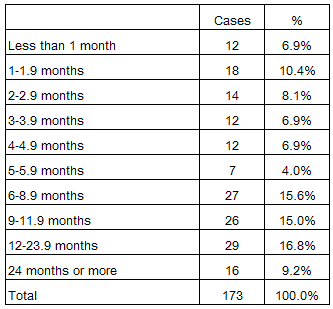
Policy Contribution
This survey Research was based on a requirement for analysis of cases of conciliation, labour tribunal and court settlement in the revised “Japan Revitalization Strategy” of 2014 (decided by the Cabinet on June 24, 2014). The Strategy also states that “Based on the results of this analysis, the Government will develop a usable tool within one year.” This tool is to be developed and provided for general use by the Ministry of Health, Labour and Welfare based on the results of this survey Research, which is thus expected to contribute directly to policy in this form.
Furthermore, together with the results of Research on dispute resolution systems in other countries as required by the Strategy and implemented by JILPT, it is expected to contribute to “creating a more predictable labour dispute resolution system”, one of the targets set in the Strategy.
Contents
- JILPT Research Report No.174, full text (PDF: 726KB) [in Japanese]
Research Category
Themed Research “Status Survey on Employment Termination in Japan”
Research Period
FY2014
Researchers
- Keiichiro HAMAGUCHI
- Senior Research Director, The Japan Institute for Labour Policy and Training
- Yoko TAKAHASHI
- Researcher, The Japan Institute for Labour Policy and Training
Category
Working conditions / Work environment, Industrial relations, Employment / Unemployment, Labor laws / Working rules
JILPT Research Report at a Glance
| To view PDF files, you will need Adobe Acrobat Reader Software installed on your computer.The Adobe Acrobat Reader can be downloaded from this banner. |

